On 10 October 2018, the U.S. Army Training and Doctrine Command (TRADOC) G-2’s Mad Scientist Initiative launched a crowdsourcing exercise to explore the possibilities and impacts of Artificial Intelligence (AI) on the future battlefield. For good reason, much has been made of AI and Machine Learning 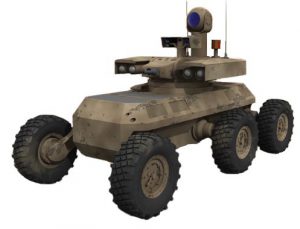 (ML) and their use in enabling lethal autonomy on the battlefield. While this is an important topic, AI’s potential application is much broader and farther, enabling future warfare at machine speed and disrupting human-centered battlefield rhythms.
(ML) and their use in enabling lethal autonomy on the battlefield. While this is an important topic, AI’s potential application is much broader and farther, enabling future warfare at machine speed and disrupting human-centered battlefield rhythms.
Mad Scientist received submissions from approximately 115 participants, affiliated with military units, Government agencies, private tech companies, academia, and a number of non-DoD/Government associated sources. These submissions were diverse and rich in depth, clarity, and quality. We distilled them into the following eight cross-cutting takeaways impacting every aspect of the future battlefield:
- Invisible AI:
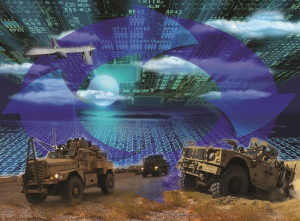 AI will be so pervasive across the battlefield that most of its functions and processes will take place without warfighters and commanders noticing. There won’t be an On/Off button per se, similar to cellular service, smart device functions, or cyber operations. The wide proliferation of AI entities from devices to platforms to even wearables means it will not be an isolated domain, but rather will permeate ubiquitously and seamlessly across the battlefield.
AI will be so pervasive across the battlefield that most of its functions and processes will take place without warfighters and commanders noticing. There won’t be an On/Off button per se, similar to cellular service, smart device functions, or cyber operations. The wide proliferation of AI entities from devices to platforms to even wearables means it will not be an isolated domain, but rather will permeate ubiquitously and seamlessly across the battlefield.
- Speed it Up:
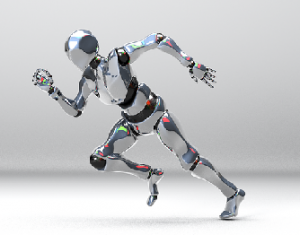 AI will not only speed up existing processes and cycles – i.e., the military decision-making process (MDMP), the intelligence cycle, the targeting cycle – but it will also likely transform them. Many of these cycles and processes have evolved and proven their effectiveness in a human-centric environment. Some contain consecutive steps that may no longer be necessary when tasks are assigned to intelligent machines. Critical, time-sensitive, but often tedious work that is carried out by hundreds of military staff members in many hours could be accomplished in minutes by AI, leading to flattened command structures, smaller staffs, and significant demand and signature reduction on the battlefield. All of this will result in battlefield optimization and will induce hyperactivity in combat – rapidly changing battlefield rhythms.
AI will not only speed up existing processes and cycles – i.e., the military decision-making process (MDMP), the intelligence cycle, the targeting cycle – but it will also likely transform them. Many of these cycles and processes have evolved and proven their effectiveness in a human-centric environment. Some contain consecutive steps that may no longer be necessary when tasks are assigned to intelligent machines. Critical, time-sensitive, but often tedious work that is carried out by hundreds of military staff members in many hours could be accomplished in minutes by AI, leading to flattened command structures, smaller staffs, and significant demand and signature reduction on the battlefield. All of this will result in battlefield optimization and will induce hyperactivity in combat – rapidly changing battlefield rhythms.
- Coup d’œil / Freeing up Warfighters and Commanders:
 AI intelligence systems and entities conducting machine speed collection, collation, and analysis of battlefield information will free up warfighters and commanders to do what they do best — fight and make decisions, respectively. Commanders can focus on the battle with coup d’œil, or the “stroke of an eye,” maintaining situational awareness without consuming precious time crunching data. Additionally, AI’s ability to quickly sift through and analyze the plethora of input received from across the battlefield, fused with the lessons learned data from thousands of previous engagements, will lessen the commander’s dependence on having had direct personal combat experience with conditions similar to his current fight when making command decisions.
AI intelligence systems and entities conducting machine speed collection, collation, and analysis of battlefield information will free up warfighters and commanders to do what they do best — fight and make decisions, respectively. Commanders can focus on the battle with coup d’œil, or the “stroke of an eye,” maintaining situational awareness without consuming precious time crunching data. Additionally, AI’s ability to quickly sift through and analyze the plethora of input received from across the battlefield, fused with the lessons learned data from thousands of previous engagements, will lessen the commander’s dependence on having had direct personal combat experience with conditions similar to his current fight when making command decisions.
- Spectrum Management and Common Operational Picture (COP):
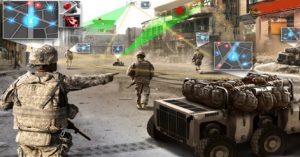 The future battlefield will be increasingly complex with the cyber, air, and space domains, as well as electromagnetic spectrum becoming difficult to see, manage, and deconflict. Exacerbating this problem is the enormous growth of the Internet of Things – eventually the Internet of Everything – and even more importantly, the Internet of Battlefield Things. AI will be critical in processing and sustaining a clear COP in this overwhelmingly data-rich environment of sensors, emitters, systems, and networks.
The future battlefield will be increasingly complex with the cyber, air, and space domains, as well as electromagnetic spectrum becoming difficult to see, manage, and deconflict. Exacerbating this problem is the enormous growth of the Internet of Things – eventually the Internet of Everything – and even more importantly, the Internet of Battlefield Things. AI will be critical in processing and sustaining a clear COP in this overwhelmingly data-rich environment of sensors, emitters, systems, and networks.
- Learning Things and Collaborative Entities:
 AI will facilitate a host of new learning things on the battlefield – i.e., weapon systems, munitions, vehicles, wearables [exo-skeletons] – and a multitude of collaborative entities – sensors, systems, and platforms. This battlespace of learning things will not supplant our need for Soldiers that use and operate them, but it will enhance them as Warfighters.
AI will facilitate a host of new learning things on the battlefield – i.e., weapon systems, munitions, vehicles, wearables [exo-skeletons] – and a multitude of collaborative entities – sensors, systems, and platforms. This battlespace of learning things will not supplant our need for Soldiers that use and operate them, but it will enhance them as Warfighters.
- Resilient and Layered AI:
 In order to effectively utilize AI across the battlefield, the Army will need resilient and layered AI, including on-board services, localized collaborative systems, and cloud services that do not rely on persistent connectivity. Some AI entities will need to be proliferated at the tactical level, creating a veritable network that can still effectively operate with degraded/disrupted nodes.
In order to effectively utilize AI across the battlefield, the Army will need resilient and layered AI, including on-board services, localized collaborative systems, and cloud services that do not rely on persistent connectivity. Some AI entities will need to be proliferated at the tactical level, creating a veritable network that can still effectively operate with degraded/disrupted nodes.
- New Required Capabilities and Skillsets:
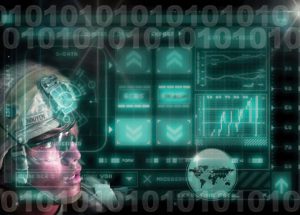 The advent of AI across the battlefield will require a multitude of new capabilities and skillsets to implement, maintain, and maximize AI entities. As with the contemporary drive to recruit Cyber talent into the ranks, the Army must plan on competing with the private sector for the most talented and capable recruits in new AI job fields.
The advent of AI across the battlefield will require a multitude of new capabilities and skillsets to implement, maintain, and maximize AI entities. As with the contemporary drive to recruit Cyber talent into the ranks, the Army must plan on competing with the private sector for the most talented and capable recruits in new AI job fields.
- Adversarial Risk:
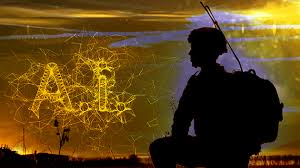 A capability / vulnerability paradox is inherent with AI, with its machine speed capabilities being vulnerable to the vast array of data input sources that it needs to operate. AI’s underpinning data and algorithms are vulnerable to spoofing, degradation, or other forms of subversion. This could lead to the erosion of Soldier and Leader trust in AI, and also necessitates more transparency to strengthen the man-machine relationship. Enemies will seek to exploit this relationship and trust.
A capability / vulnerability paradox is inherent with AI, with its machine speed capabilities being vulnerable to the vast array of data input sources that it needs to operate. AI’s underpinning data and algorithms are vulnerable to spoofing, degradation, or other forms of subversion. This could lead to the erosion of Soldier and Leader trust in AI, and also necessitates more transparency to strengthen the man-machine relationship. Enemies will seek to exploit this relationship and trust.
Conclusion:
These takeaways illustrate the many ways AI can be implemented across the future battlefield. Machine speed warfare will be enabled by AI; it will not be limited to just lethal autonomy. The functions of so many other parts of combat – C2, ISR, sustainment, medical, etc. – can be accelerated and improved; not just “warheads on foreheads.”

While we explored where AI could enhance battlefield operations, there are also implicit considerations that must be accounted for in the future. These include the ethical dilemmas and concerns associated with employing AI in so many different ways. Lethal autonomy is a hot button issue due to its life or death implications. However, AI assisting other warfighter functions will also have significant impacts on the battlefield.
A second major consideration is what impact AI has on Army learning and training. The Army will not only have to incorporate the subject of AI in its learning but will also utilize AI in its learning. Additionally, AI will be required to support Field Training Exercises and other major training events to work through all of the second and third order effects resulting from a much more compressed battle rhythm.
 Mad Scientist is extremely appreciative of all the feedback and submissions received. We intend for this product to be used in future wargaming events, future horizon scanning, and the general framing of future thinking and planning for the development and use of AI systems and entities.
Mad Scientist is extremely appreciative of all the feedback and submissions received. We intend for this product to be used in future wargaming events, future horizon scanning, and the general framing of future thinking and planning for the development and use of AI systems and entities.
If you enjoyed this blog post, please read the entire Crowdsourcing the Future of the AI Battlefield paper, including the highlights of ideas binned into categories supporting upcoming Army Wargames on Intelligence, Surveillance, and Reconnaissance; Logistics; and Command and Control.



